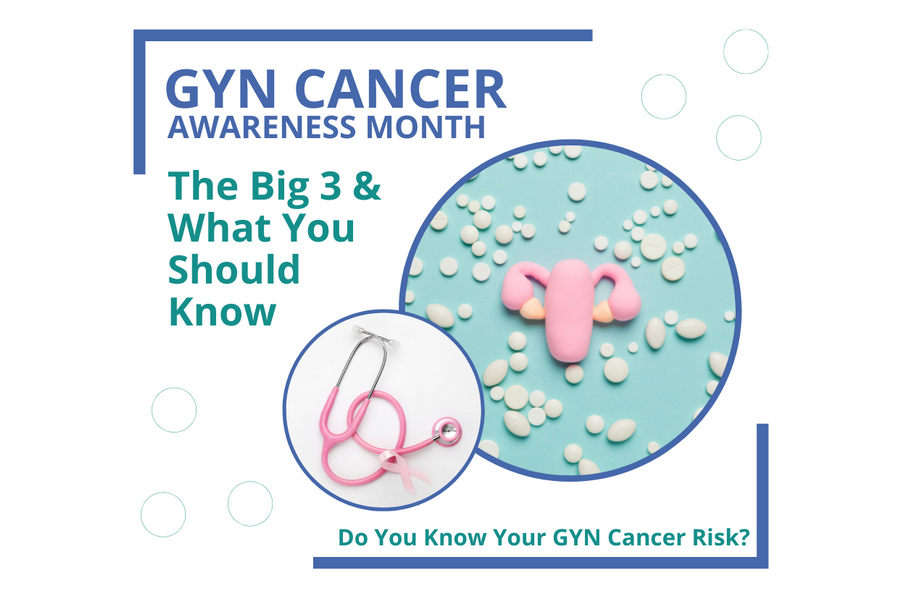September marks Gynecologic Cancer Awareness Month. So, I wanted to take some time to highlight not only the awareness of these cancers but also the symptoms and screening measures that women should be aware about. After all, early diagnosis can lead to early treatment—and thus, improved survival rates, recovery, and health outcomes.
So, how can you reduce your gynecologic cancer risk? What kind of testing should you undergo? Below, I highlight the big three; cervical cancer, ovarian cancer, and uterine cancer. Yes, the “C” word sounds scary, but knowledge is power! So, let’s dig in.
1. Cervical Cancer
My personal experience with HPV came from a negative pap smear and a positive high-risk HPV test. Due to other concerning symptoms, I requested additional testing, and I am glad I did. Here I am, a non-smoker, healthy, in a monogamous relationship, and ended up with a diagnosis of adenocarcinoma in situ (AIS), an early-stage pre-cancer. In the end, I’m glad I listened to my body and took the necessary steps beyond routine recommendations.
The World Health Organization (WHO) states that over 95% of cervical cancers are caused by the human papillomavirus (HPV). In fact, HPV is the most common virus that impacts the reproductive tract. Surprisingly, most of us will be infected with this virus at some point in our lives—we just might not know it!
This is largely because HPV tends to clear up all on its own. Furthermore, any pre-cancerous tissue produced from HPV also tends to resolve all on its own.
Yet, a small percentage goes on to develop cervical cancer. Not only that, but HPV can also lead to other cancers, including vaginal, vulva, anus, and oropharynx. Now, I’m not voicing this to freak anybody out. Rather, I want to get the word out about how HPV can manifest into various cancers, not just cervical cancer.
Okay, so what is HPV exactly?
HPV is actually a broad term used to describe over 100 viruses. Typically, it doesn’t cause any problems. Yet, some may experience the development of warts—or, worst case, cancer. HPV spreads via skin-to-skin contact, vaginal, anal, or oral sex, and even by sharing sex toys.
Luckily, there is screening and testing available for HPV. It involves a screening test offered in routine gynecologic visits, and speaking as an OB/GYN with prior AIS, it is one of the most preventable ways to prevent cervical cancer, as well as knowing and understanding your status. If you’ve ever had an abnormal pap smear test, you might be familiar with this. Your doctor may send you to a specialist for a cervical screening, where a small sample of cells is taken and tested for HPV.
Additionally, there is the newer HPV vaccine, thanks to scientific and technological advances. Since this vaccine was introduced in 2006, the CDC reports a significant drop in HPV infections and cervical precancers. The first dose is recommended for girls between ages 11 and 12, and the second dose is recommended six to 12 months after the first. Usually, it isn’t recommended for sexually-active adults due to the high likelihood that they have already previously been exposed to HPV.
2. Ovarian Cancer
Sadly, ovarian cancer accounts for the most deaths than any other cancer affecting the female reproductive system. Each year in the United States, almost 20,000 women are diagnosed with ovarian cancer, with another almost 13,000 dying from it.
The unfortunate truth is that there is no “true” regular screening regime for this type of cancer. Rather, when signs that something isn’t right arise, a woman may undergo testing in the form of a transvaginal ultrasound or a CA-125 blood test.
Symptoms of ovarian cancer often include:
- Abdominal swelling/bloating
- Feeling full quickly when eating
- Pelvic discomfort/pain
- Weight loss
- Back pain
- Fatigue
- Constipation or changes in bowel movements
- Frequent urination
Yet, at the same time, FemTech companies are attempting to bridge this gap and make early screening possible, especially for high-risk women (Ovarian cancer commonly occurs in women ages 55-64 years old). Some research shows that potentially collecting data from vaginal secretions, which have a higher amount of biomarkers than blood, could give way to early detection. And there’s more than one FemTech research group focusing on this!
AOA DX is one of the companies determining whether liquid biopsy tests could offer early detection of this type of cancer, leading to improved survival rates. It’s exciting! Just think, in a matter of a few years, we could have a much better way to screen for ovarian cancer, potentially saving thousands and, eventually, millions of lives!
3. Uterine Cancer
Uterine cancer comes in two forms; endometrial cancer and uterine sarcomas. Endometrial cancer impacts the lining of the uterus. This type makes up about 95% of all uterine cancer cases. Meanwhile, uterine sarcoma is much rarer and happens when cancer develops in the muscle tissue of the uterus.
In the United States, almost 66,000 women are diagnosed with uterine cancer each year. The most common symptom of this type of cancer is unusual vaginal bleeding, particularly vaginal bleeding occurring after menopause.
Some other symptoms may include:
- Heavier periods
- Vaginal bleeding between periods
- Continuous periods
- A watery discharge with a potent smell
- Unexplained weight loss
- Trouble urinating
- Abdominal pain
Shockingly, women of color have the highest death rates from uterine cancer. In fact, non-Hispanic Black women experience double the death rates from uterine cancer than other groups of women. The New York Times further reports that non-Hispanic Black women are more likely to develop non-endometrioid uterine cancer, which is actually a more aggressive type. In many ways, uterine cancer is an outlier when it comes to narrowing the racial gap in cancer rates.
Another twist: It’s not entirely known why this is the case. However, we can develop a few theories here. Uterine cancer is higher amongst those with high estrogen exposure, which is often due to obesity. Obesity can be attributed to a lack of funding when it comes to health care, and health care access. Obesity is a rising epidemic influenced by many factors and also our environment and diet.
On top of this, according to the statistics, Black and Hispanic women are less likely to undergo hysterectomies than Caucasian women, less likely to have a biopsy performed on their lymph nodes to detect cancer, and less likely to seek out chemotherapy with a cancer diagnosis. There are also stories of Black women seeking out health advice due to potential uterine cancer symptoms but not getting a proper diagnosis for months and, sometimes, years. Some experts attribute this to the fact that ultrasound scans can’t necessarily detect this aggressive form of cancer, or even women feeling like their concerns are not valued, heard, or trusted by their health care provider. And to me, this is a clear sign that something is broken in our healthcare system. Guidelines need to be reviewed and changed to cater to every woman, especially for those noted as being potentially higher risk.
Know the Signs & Get Tested
Like I said, knowledge is power! Knowing the signs of the above cancers and seeking out appropriate screenings can help you and your loved ones receive early diagnosis and early care.
At the end of the day, we all know someone that has had cancer or died from cancer. It’s an awful disease to face. Yet, with early detection and regular screenings (C’mon FemTech and research!), we can go forward into the future hopeful. At the same time, raising awareness and funding still reigns supreme to propel this research and innovative development forward. So, during this GYN Cancer Awareness month, walk that walk. Donate. Discuss testing and screening for these cancers with your doctor. And get involved in your local area!
When we heal women… We heal the world.
LaReesa Ferdinand, MD
Visit www.drlareesa.com
Follow us on
Instagram @drlareesa





